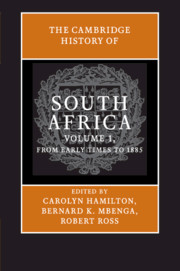Book contents
- Frontmatter
- 1 The Production of Preindustrial South African History
- 2 The Appearance of Food Production in Southern Africa 1,000 to 2,000 Years Ago
- 3 Farming Communities of the Second Millennium: Internal Frontiers, Identity, Continuity and Change
- 4 Khoesan and Immigrants: The Emergence of Colonial Society in the Cape, 1500–1800
- 5 Turbulent Times: Political Transformations in the North and East, 1760s–1830s
- 6 From Slave Economy to Settler Capitalism: The Cape Colony and Its Extensions, 1800–1854
- 7 From Colonial Hegemonies to Imperial Conquest, 1840–1880
- 8 Transformations in Consciousness
- Index
- References
1 - The Production of Preindustrial South African History
Published online by Cambridge University Press: 28 September 2010
- Frontmatter
- 1 The Production of Preindustrial South African History
- 2 The Appearance of Food Production in Southern Africa 1,000 to 2,000 Years Ago
- 3 Farming Communities of the Second Millennium: Internal Frontiers, Identity, Continuity and Change
- 4 Khoesan and Immigrants: The Emergence of Colonial Society in the Cape, 1500–1800
- 5 Turbulent Times: Political Transformations in the North and East, 1760s–1830s
- 6 From Slave Economy to Settler Capitalism: The Cape Colony and Its Extensions, 1800–1854
- 7 From Colonial Hegemonies to Imperial Conquest, 1840–1880
- 8 Transformations in Consciousness
- Index
- References
Summary
INTRODUCTION
A new and distinctively post-apartheid historiography has yet to find its feet in relation to the period covered by this volume. Since 1994, when the first democratic elections were held in South Africa, there have been significant changes in the nature of public discourses about South Africa’s past. Settlerist and narrow nationalist (notably Afrikaner and Zulu) historical projects have, unsurprisingly, largely lost their impetus. Government efforts led by the African National Congress to invoke a new national past rooted in the black struggle against oppression have focused primarily on the twentieth century. The effort to achieve reconciliation and unity initially moved to deflect public discourse away from attending to the past except as it was manifested in the proceedings of, and the texts that flowed from the Truth and Reconciliation Commission set up in 1995, and in a handful of legacy projects undertaken by the Department of Arts, Culture, Science and Technology. Concomitantly, the 1990s saw the rapid growth of the particular genre of history commonly known as heritage – celebrating, commemorating, and often commodifying selected aspects of the past. Although heritage and public history courses and research have flourished, universities have experienced a sharp decline in the numbers of students enrolled in mainstream history courses, and the substantial cohorts of graduate students undertaking primary historical research, a feature of the radical history movement of the 1980s, have evaporated.
Small but encouraging signs of things to come are discernible in a variety of areas. Significant challenges lie in how to approach, or augment, the available archive for the period covered by this volume – an archive for the most part powerfully shaped by the colonial and later apartheid eras in which it was established – to facilitate new kinds of research. Key secondary texts that have given definition to how this period is understood themselves require critical review. Likewise, the exclusion of other texts from the historical canon may warrant reassessment.
- Type
- Chapter
- Information
- The Cambridge History of South Africa , pp. 1 - 62Publisher: Cambridge University PressPrint publication year: 2009
References
- 1
- Cited by



